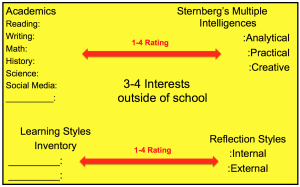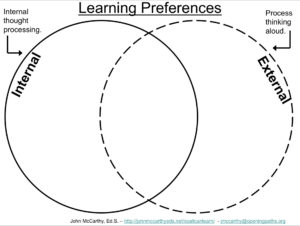Differentiation | Planning | Readiness | Interests | Learning Preferences | Strategies Alignment | Planning Toolkit
When using learning preferences there are many approaches to choose from. It should be less about which ones to choose, and more about “how” they are implemented.
| Sternberg’s Triarchic Theory of Multiple Intelligences | Gardner’s Theory on Multiple Intelligences |
| VAK (visual, auditory, kinesthetic) |
Others |
In the book, “Visible Learning and the Science of How We Learn”, John Hattie and Gregory Yates reviewed the literature on studies done about VAK learning styles and found:
“in considering the various learning styles posited, we reach a clear conclusion: that there is not any recognized evidence suggesting that knowing or diagnosing learning styles will help you to teach your students any better than not knowing their learning style (p. 176).”
However they did find that:
“Of course, all students benefit from instruction that encompasses analyzing images, hearing words, and acting out key aspects (p. 181).”
A main takeaway from these findings is that learning preferences, not learning styles, should be used to see multiple facets of how a student learns. They should not be used to corner a learner as finding success in only one way. The strategies shared below are intended to collect student information and use it to use specific activities that can provide varied experiences in a single timeframe.
Example Strategies
Learning Preferences Cards (learn more)
Collect 3 types of data from students about themselves: Academic strengths, Personal Interests, and Learning Preferences. Use the information to shape lessons, personalize learning, shape groups, and inform how best to interact or engage in collaboration.
Learning Preference Quick Surveys (learn more)
Use this tool to gage the learning culture of the class. The specific data to students may be hard to track individually, yet the full view of the class becomes clear as to how they may respond to different types of direct instruction and student-led learning.
Wait Time (learn more)
Intended for when a question is asked that students should know the answer. Give 5-15 seconds for students to think about how they want to answer a question that has just been asked. Sometimes give 20-30 seconds of silent reflection for deeper thought about a question or prompt before engaging in dialog in small groups or whole class. It honors that there are external and internal thinkers. The internal thinkers value the time.
Think Time (learn more)
Used when learners need time to consider how to best puzzle together an answer. Time provided might be 30 seconds to 2 or 3 minutes. This is time for individual journaling, silent reflection, or partner talk. It honors that there are external and internal thinkers. The internal thinkers value the time.
3-D Instruction
Take a traditional lesson or activity, and incorporate 3 learning preferences styles into the options or tasks. All students can experience all of the tasks, thus getting multiple perspectives on a concept for deeper learning. Or, students can choose from the options to complete activities based on the choices that make the most sense to them. In both cases, students are experiencing instruction in multiple ways. This is unlike traditional lessons where content is usually presented in one way, which only serves well a portion of the students. 3-D Instruction gives all learners opportunities to build genuine connections. Here are example activities or structures that are perfect for incorporating tasks that use at least 3 different learning preferences:
- Think Dots (learn more)
This activity include 6 task (2 rows of 3 squares). The squares are numbered from 1-6. Usually in groups of 2-4, students collectively choose tasks in any order of preference to complete. Cubing is a similar strategy where the tasks are put onto the cube sides. Students role it to complete tasks in a randomized order. - Task Cards
This activity can include as many task cards as desired or needed. Similar to Think Dots, except that each square is on a separate card, and there can be more or less than 6. They are usually kept on a key ring or wrapped in a rubber band. Depending on directions, learners (individually or in small groups) work through the cards in sequence or random order. - Think-Tac-Toe (learn more)
This tic-tac-toe format of 3×3 or 4×4 includes tasks in each square. Some rules require completion of 3 or 4 in a row. My preference is requiring completion of either one per row or per column. - Learning Centers & Stations (learn more)
Centers or stations are set up with different tasks. Learners move through each location to complete the work. In this case, the assignments are embedded with 3-D Instruction experiences.
Student Voice on Tools
Learners know what appeals to them better then anyone. Help them understand the value of finding tools that resonate with how they prefer to learn, or what makes sense to them in how a tool works. Then give them a list of tools and set them loose to blaze their own paths. This list of 100+ tools (related article) is a good place to start, or consider the examples below:
- Presentation choices: Powtoons, Adobe CC Express, EMaze or Google Slides
- Organizing content choices: Padlet or MindMup
Supporting Resources
